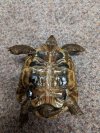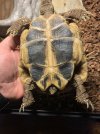You are using an out of date browser. It may not display this or other websites correctly.
You should upgrade or use an alternative browser.
You should upgrade or use an alternative browser.
Name that Greek!
- Thread starter ogden55
- Start date
Hello and welcome. I'm afraid I don't know enough to identify him, but I just wanted to say that he is a very goodlooking tortoise. How old is he?This is archimedes, a Greek tortoise we are taking in from a friend. Can anyone identify the subspecies for me? I am having a hard time determining, thanks! I can post more pictures if it is helpful.
Angie (from UK)
I’m not quite sure on his age, my friend had him for about 2-3 years from when they purchased him and I don’t know where they got him from or how big he was at the time. I’ll measure him when I get home from work. Maybe his size can help determine approximately how old he is.Hello and welcome. I'm afraid I don't know enough to identify him, but I just wanted to say that he is a very goodlooking tortoise. How old is he?
Angie (from UK)
I'm sure that someone who knows more than me wiill be able to help you, but I think it would be very useful if you could get together some photos of his shell, including the plastron, and also of where you are keeping him, and details about his diet etc. His size and weight would help too. Then people here will be able to discuss his care and so on with you. There are lots of very knowledgeable people here, - and very helpful and kind, too.I’m not quite sure on his age, my friend had him for about 2-3 years from when they purchased him and I don’t know where they got him from or how big he was at the time. I’ll measure him when I get home from work. Maybe his size can help determine approximately how old he is.
Do you have any other tortoises already?
Angie
PollyAda
Active Member
Hi there. Are you certain he is a Greek? Does he have spurs on his thighs either side of the tail? If the spurs are absent and he has a horn like tip to the tail then he may be an Eastern Hermann's.This is archimedes, a Greek tortoise we are taking in from a friend. Can anyone identify the subspecies for me? I am having a hard time determining, thanks! I can post more pictures if it is helpful.
Hi and welcome! I don't know much about Greek tortoises, but I see that ramped water bowl which needs to be removed and replaced with a terracotta saucer sunk into the substrate instead. The ramped dish is a tipping hazard for the tortoise. Also it's best to put his food on a flat slate or tile, rough side up.
I used to own a leopard tortoise years ago so I have some knowledge about tortoise care but I am new to a Greek tortoise. This is the previous owners tank. I will be moving him to an outdoor enclosure over this summer while I get a larger tank and different set up for him. He is smaller than what I’m used to so I would like to have him inside mostly, what are some tank size recommendations? He is currently in a 75 gallon and his plastron is about 5 inches in length from head to tail.Hi and welcome! I don't know much about Greek tortoises, but I see that ramped water bowl which needs to be removed and replaced with a terracotta saucer sunk into the substrate instead. The ramped dish is a tipping hazard for the tortoise. Also it's best to put his food on a flat slate or tile, rough side up.
With those pictures, I'm pretty sure you have a female Eastern Hermann's tortoise. The coloring and shape of the scutes on the plastron (bottom shell) are easy ways to identify an Eastern Hermann's tortoise.
Other than the tail (mine is male) and some slight differences in color pattern, she looks almost exactly like my male Eastern Hermann's.
Here's mine for comparison: (He just had a soak before these pictures so he's a little extra shiny due to the water)



p.s. He's about four years old and seems to be going through "puberty" with some pretty significant growth spurts so the bold almost white lines are growth lines and not actually part of his normal coloring pattern.
Other than the tail (mine is male) and some slight differences in color pattern, she looks almost exactly like my male Eastern Hermann's.
Here's mine for comparison: (He just had a soak before these pictures so he's a little extra shiny due to the water)



p.s. He's about four years old and seems to be going through "puberty" with some pretty significant growth spurts so the bold almost white lines are growth lines and not actually part of his normal coloring pattern.
To answer some of the other parts of your question, even a shallow (breeder) 75 gallon tank really is much too small for a small species of tortoise like the Hermann's. A normal (tall) 75 gallon tank is definitely too small. It's a lot better than the 40 gallon (or smaller) sized tanks that a lot of badly informed pet shops recommend, but at around 4' x 2' (average 75 gallon tank size) it's about one quarter of the recommended minimum space for a happy, healthy adult Hermann's Tortoise. Many people (myself included) simply don't have room for a 4' x 8' indoor enclosure, but you should give her as much space as you possibly can.
It looks like you are using ReptiBark substrate, or something similar, and that's what I have as a layer on top of a deeper layer of coconut coir "dirt". If it is only ReptiBark in your enclosure, make sure it is at least a few inches deep so the tortoise can burrow in if she wants to. Also, make sure you clean up the poop balls/logs on a regular basis so the enclosure doesn't get gross. This will help prevent bad smells, and also reduce the risk of illness. It's hard to tell for certain and they might just be darker pieces of bark, but there are several bits that look like tortoise poop around her back legs in your last picture.
Many people here will tell you to get rid of that sloped plastic water dish as they can be death traps for smaller tortoises, but my personal opinion is that is more of an issue with very young and very small tortoises who are unable to climb out and could drown or develop illnesses related to getting too cold while stuck in the water. A 5 inch (plus) adult shouldn't have that problem, especially if you keep the water level in the dish fairly shallow. I actually used to have one of those but I got rid of it and went with a much smaller reptile water dish, mostly because my Hermes kept using the big bowl as a toilet instead of a water dish so I had to clean it out VERY frequently. I give him warm water soaks in a tub a couple of times a week and he enjoys getting that water nice and filthy and keeps his actual drinking water dish very clean now so I think it's a much better arrangement.
The slate or sandstone basking stone near the water dish in your photo is a good idea, but it might be more effective to have a stone big enough that your tortoise can stretch out her legs to collect extra warmth and still be completely on the stone if she wants to. I have two slate stones in my indoor enclosure right now. A somewhat small one away from all heat sources where I put his food, and a larger one directly below the basking lamp. Putting the food on a stone helps keeps things a bit cleaner and also helps keep the tortoise's beak ground down so it doesn't have to be manually trimmed.
It looks like you are using ReptiBark substrate, or something similar, and that's what I have as a layer on top of a deeper layer of coconut coir "dirt". If it is only ReptiBark in your enclosure, make sure it is at least a few inches deep so the tortoise can burrow in if she wants to. Also, make sure you clean up the poop balls/logs on a regular basis so the enclosure doesn't get gross. This will help prevent bad smells, and also reduce the risk of illness. It's hard to tell for certain and they might just be darker pieces of bark, but there are several bits that look like tortoise poop around her back legs in your last picture.
Many people here will tell you to get rid of that sloped plastic water dish as they can be death traps for smaller tortoises, but my personal opinion is that is more of an issue with very young and very small tortoises who are unable to climb out and could drown or develop illnesses related to getting too cold while stuck in the water. A 5 inch (plus) adult shouldn't have that problem, especially if you keep the water level in the dish fairly shallow. I actually used to have one of those but I got rid of it and went with a much smaller reptile water dish, mostly because my Hermes kept using the big bowl as a toilet instead of a water dish so I had to clean it out VERY frequently. I give him warm water soaks in a tub a couple of times a week and he enjoys getting that water nice and filthy and keeps his actual drinking water dish very clean now so I think it's a much better arrangement.
The slate or sandstone basking stone near the water dish in your photo is a good idea, but it might be more effective to have a stone big enough that your tortoise can stretch out her legs to collect extra warmth and still be completely on the stone if she wants to. I have two slate stones in my indoor enclosure right now. A somewhat small one away from all heat sources where I put his food, and a larger one directly below the basking lamp. Putting the food on a stone helps keeps things a bit cleaner and also helps keep the tortoise's beak ground down so it doesn't have to be manually trimmed.
Thank you so much for the reply, after comparing her with other pictures she does look way more similar to an eastern hermanns than T.G. Graeca. Just curious how are you able to tell on the sex, is it by the colors? Is there a thread you could link for hermanns care guide? I just want to do the best I can for her that way she is happy.To answer some of the other parts of your question, even a shallow (breeder) 75 gallon tank really is much too small for a small species of tortoise like the Hermann's. A normal (tall) 75 gallon tank is definitely too small. It's a lot better than the 40 gallon (or smaller) sized tanks that a lot of badly informed pet shops recommend, but at around 4' x 2' (average 75 gallon tank size) it's about one quarter of the recommended minimum space for a happy, healthy adult Hermann's Tortoise. Many people (myself included) simply don't have room for a 4' x 8' indoor enclosure, but you should give her as much space as you possibly can.
It looks like you are using ReptiBark substrate, or something similar, and that's what I have as a layer on top of a deeper layer of coconut coir "dirt". If it is only ReptiBark in your enclosure, make sure it is at least a few inches deep so the tortoise can burrow in if she wants to. Also, make sure you clean up the poop balls/logs on a regular basis so the enclosure doesn't get gross. This will help prevent bad smells, and also reduce the risk of illness. It's hard to tell for certain and they might just be darker pieces of bark, but there are several bits that look like tortoise poop around her back legs in your last picture.
Many people here will tell you to get rid of that sloped plastic water dish as they can be death traps for smaller tortoises, but my personal opinion is that is more of an issue with very young and very small tortoises who are unable to climb out and could drown or develop illnesses related to getting too cold while stuck in the water. A 5 inch (plus) adult shouldn't have that problem, especially if you keep the water level in the dish fairly shallow. I actually used to have one of those but I got rid of it and went with a much smaller reptile water dish, mostly because my Hermes kept using the big bowl as a toilet instead of a water dish so I had to clean it out VERY frequently. I give him warm water soaks in a tub a couple of times a week and he enjoys getting that water nice and filthy and keeps his actual drinking water dish very clean now so I think it's a much better arrangement.
The slate or sandstone basking stone near the water dish in your photo is a good idea, but it might be more effective to have a stone big enough that your tortoise can stretch out her legs to collect extra warmth and still be completely on the stone if she wants to. I have two slate stones in my indoor enclosure right now. A somewhat small one away from all heat sources where I put his food, and a larger one directly below the basking lamp. Putting the food on a stone helps keeps things a bit cleaner and also helps keep the tortoise's beak ground down so it doesn't have to be manually trimmed.
Look at the tail. See how yours has a very short, fat tail while mine has a very long tail with a bony barb on the end? Short fat tail is female. Long narrow tail is male. Female Hermann's often have a bony barb on the end as well, but it's usually smaller and adult males always have a very pronounced barb.
It is possible that your friend bought the tortoise when it was a baby and so it is only actually 2-3 years old. If that is the case, it could simply not be old enough to tell for sure and could still be a male. But the size of the tortoise and large number of growth lines make me think it's definitely older than that, and from the pictures it looks like a female to me.
It is possible that your friend bought the tortoise when it was a baby and so it is only actually 2-3 years old. If that is the case, it could simply not be old enough to tell for sure and could still be a male. But the size of the tortoise and large number of growth lines make me think it's definitely older than that, and from the pictures it looks like a female to me.
I'm inclined to agree with you but the picture is a bit darkHi there. Are you certain he is a Greek? Does he have spurs on his thighs either side of the tail? If the spurs are absent and he has a horn like tip to the tail then he may be an Eastern Hermann's.
MaNaAk
You have to know the date of birth of a tortoise to know its age.I’m not quite sure on his age, my friend had him for about 2-3 years from when they purchased him and I don’t know where they got him from or how big he was at the time. I’ll measure him when I get home from work. Maybe his size can help determine approximately how old he is.
The tail shape is how we tell. if you look at yours it is more stumpy and triangle shape but the other pic the tail is long and curls to the side. At a young age nothing is 100% but I go for your new charge being female. They are best solo so please do not consider a friend. Have a read of the care sheet and review the set up to give it the best environment to be a smooth shelled healthy shelled warrior.
 tortoiseforum.org
tortoiseforum.org
Info For New People. Please Read This First.
Hello and welcome to tortoiseforum.org! We are all glad you are here! There is no other forum like this anywhere. We have tens of thousands of members from all over the world ranging from kids with their first tortoise to people who have been breeding and keeping high end tortoises since the...
Similar threads
- Replies
- 2
- Views
- 820
New Posts
-
-
-
Setting up for a Russian Tortoise - Constructive comments welcome
- Latest: David Steere
-
-




